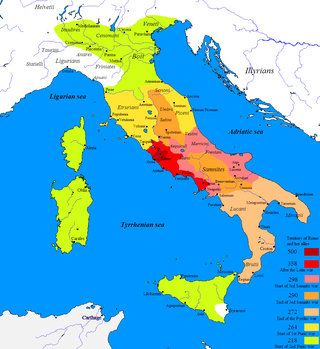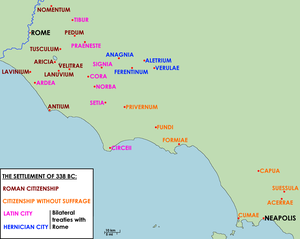
Year 290 BC was a year of the pre-Julian Roman calendar. At the time it was known as the Year of the Consulship of Rufinus and Dentatus. The denomination 290 BC for this year has been used since the early medieval period, when the Anno Domini calendar era became the prevalent method in Europe for naming years.

Polis, plural poleis, means 'city' in Greek. In Ancient Greece, it originally referred to an administrative and religious city center as distinct from the rest of the city. Later, it also came to mean the body of citizens under a city's jurisdiction. In modern historiography, the term is normally used to refer to the ancient Greek city-states, such as Classical Athens and its contemporaries, and thus is often translated as 'city-state'. The poleis were not like other primordial ancient city-states such as Tyre or Sidon, which were ruled by a king or a small oligarchy; rather, they were political entities ruled by their bodies of citizens.

Citizenship in ancient Rome was a privileged political and legal status afforded to free individuals with respect to laws, property, and governance. Citizenship in Ancient Rome was complex and based upon many different laws, traditions, and cultural practices. There existed several different types of citizenship, determined by one's gender, class, and political affiliations, and the exact duties or expectations of a citizen varied throughout the history of the Roman Empire.

Fondi is a city and comune in the province of Latina, Lazio, central Italy, halfway between Rome and Naples. As of 2017, the city had a population of 39,800. The city has experienced steady population growth since the early 2000s, though this has slowed in recent years.
In ancient Rome, the Latin term Municipium referred to a town or city. Etymologically, the municipium was a social contract among municipes, or citizens of the town. The duties were a communal obligation assumed by the municipes in exchange for the privileges and protections of citizenship. Every citizen was a municeps.

Arpino is a comune (municipality) in the province of Frosinone, in the Latin Valley, region of Lazio in central Italy, about 100 km SE of Rome. Its Roman name was Arpinum. The town produced two consuls of the Roman republic: Gaius Marius and Marcus Tullius Cicero.

In Ancient Rome, the Latin term civitas, according to Cicero in the time of the late Roman Republic, was the social body of the cives, or citizens, united by law. It is the law that binds them together, giving them responsibilities on the one hand and rights of citizenship on the other. The agreement has a life of its own, creating a res publica or "public entity", into which individuals are born or accepted, and from which they die or are ejected. The civitas is not just the collective body of all the citizens, it is the contract binding them all together, because each of them is a civis.

Ariccia is a town and comune in the Metropolitan City of Rome, central Italy, 25 kilometres (16 mi) southeast of Rome. It is in the Alban Hills of the Lazio (Latium) region and could be considered an extension of Rome's southeastern suburbs. One of the Castelli Romani towns, Ariccia is located in the regional park known as the "Parco Regionale dei Castelli Romani".

Caiazzo is a city and comune in the province of Caserta (Campania) in Italy. It is located on the right bank of the Volturnus, some 20 kilometres (12 mi) northeast of Capua.
Denization is an obsolete or defunct process in England and Ireland and the later Kingdom of Great Britain, the United Kingdom, and the British Empire, dating back to the 13th century, by which an alien (foreigner), through letters patent, became a denizen, thereby obtaining certain rights otherwise normally enjoyed only by the King's subjects, including the right to hold land. The denizen was neither a subject nor an alien, but had a status akin to permanent residency today. While one could become a subject via naturalisation, this required a private act of Parliament ; in contrast, denization was cheaper, quicker, and simpler. Denization fell into obsolescence when the British Nationality and Status of Aliens Act 1914 simplified the naturalisation process.

Social class in ancient Rome was hierarchical, with multiple and overlapping social hierarchies. An individual's relative position in one might be higher or lower than in another, which complicated the social composition of Rome.

Sabina, also called the Sabine Hills, is a region in central Italy. It is named after Sabina, the territory of the ancient Sabines, which was once bordered by Latium to the south, Picenum to the east, ancient Umbria to the north and Etruria to the west. It was separated from Umbria by the River Nar, today's Nera, and from Etruria by the River Tiber.

Mentana is a town and comune, former bishopric and present Latin Catholic titular see in the Metropolitan City of Rome, Lazio, central Italy. It is located 29 kilometres (18 mi) north-east of Rome and has a population of about 23,000.
The Lex Plautia Papiria de Civitate Sociis Danda was a Roman plebiscite enacted amidst the Social War in 89 BCE. It was proposed by the Tribunes of the Plebs, M. Plautius Silvanus and C. Papirius Carbo. The law granted Roman citizenship to Italian communities that had previously rebelled against Rome during this war.
A Roman colonia was originally a Roman outpost established in conquered territory to secure it. Eventually, however, the term came to denote the highest status of a Roman city. It is also the origin of the modern term colony.

The socii or foederati were confederates of Rome and formed one of the three legal denominations in Roman Italy (Italia) along with the Roman citizens (Cives) and the Latini. The Latini, who were simultaneously special confederates and semi-citizens, should not be equated with the homonymous Italic people of which Rome was part. This tripartite organisation lasted from the Roman expansion in Italy to the Social War, when all peninsular inhabitants were awarded Roman citizenship.
The Helvii were a relatively small Celtic polity west of the Rhône river on the northern border of Gallia Narbonensis. Their territory was roughly equivalent to the Vivarais, in the modern French department of Ardèche. Alba Helviorum was their capital, possibly the Alba Augusta mentioned by Ptolemy, and usually identified with modern-day Alba-la-Romaine. In the 5th century the capital seems to have been moved to Viviers.
Social class in Italy began early on in Ancient Rome, and this article comprises more or less how it is today.
The Roman–Latin wars were a series of wars fought between ancient Rome and the Latins, from the earliest stages of the history of Rome until the final subjugation of the Latins to Rome in the aftermath of the Latin War.
The Roman conquest of the Hernici, an ancient Italic people, took place during the 4th century BC. For most of the 5th century BC, the Roman Republic had been allied with the other Latin states and the Hernici to successfully fend off the Aequi and the Volsci. In the early 4th century BC, this alliance fell apart. A war fought between Rome and the Hernici in the years 366–358 BC ended in Roman victory and the submission of the Hernici. Rome also defeated a rebellion by some Hernician cities in 307–306 BC. The rebellious Hernici were incorporated directly into the Roman Republic, while those who had stayed loyal retained their autonomy and nominal independence. In the course of the following century, the Hernici became indistinguishable from their Latin and Roman neighbours and disappeared as a separate people.












